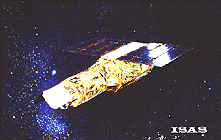ASCA
Advanced Satellite for Cosmology & Astrophysics
 ASCA, formerly named Astro-D, is a high throughput spectroscopic observatory. It is Japan's fourth cosmic X-ray mission, targeting the x-ray background, active galactic nuclei, galactic clusters, supernovae, and their remnants. Part of the scientific payload is provided by the United States. After 8 months of instrument validation, ASCA became a guest observer project, with astronomers from Japan, the US, and members states of the European Space Agency having access to the program. This is the first satellite to use CCDs for X-ray astronomy.
ASCA, formerly named Astro-D, is a high throughput spectroscopic observatory. It is Japan's fourth cosmic X-ray mission, targeting the x-ray background, active galactic nuclei, galactic clusters, supernovae, and their remnants. Part of the scientific payload is provided by the United States. After 8 months of instrument validation, ASCA became a guest observer project, with astronomers from Japan, the US, and members states of the European Space Agency having access to the program. This is the first satellite to use CCDs for X-ray astronomy.
Spacecraft
Solar arrays provide 601 W BOL/489 W after 3 yr., two 19 Ahr NiCd batteries. Attitude control <1 arcmin, determination <0.3arcmin; 3 axis control by 4 reaction wheels. Data from bubble memory recorder (134 Mb) downlinked on X-band at 264 kbit/sec. The tubular telescoping optical truss is constructed of carbon fiber which was folded for launch, and was extended by a sliding mechanism after reaching orbit.
Payload
Four x-ray telescopes, consisting of four sets of coaxially aligned multilayer thin foil mirrors
provided by GSFC. At the focus of two of the telescopes is a Gas Imaging Spectrophotometer (GIS) consisting of two gas imaging scintillation propotional counters covering 0.7-10 keV. The second focal plane instrument is a solid-state imaging spectrometer with two CCDs covering 0.5-8
keV.
| Country of Origin | Japan |
| Customer/User | ISAS |
| Size | 1.2 m max diameter, 2.82 m long (at launch), 4 m long with telescoping optical truss (in orbit) |
| Orbit | 550 km 31 deg inclination |
| Design Life | 5 years |
| Related Sites | ASCA at ISAS |
Launch Facts
| Name | Int'l Desig. | Date | Site | Vehicle | Orbit | Mass(kg) |
| Notes | ||||||
| Astro D (Asca) | 1993-011A | 2/20/93 | Kagoshima | Mu 3S2 | LEO | 420 |
| X-ray imaging and astronomy | ||||||
Information in The Mission and Spacecraft Library is provided without warranty or guarantee. USE AT YOUR OWN RISK.